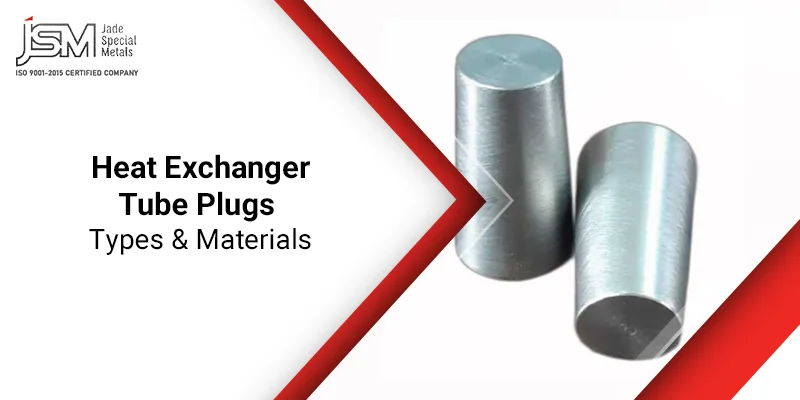Heat exchangers are the workhorses of refineries, power plants and processing facilities. They rely on bundles of slender tubes to transfer heat between two streams of fluid. When one of those tubes springs a leak, it doesn’t just waste energy, it can contaminate products, corrode neighbouring tubes and force an unscheduled shutdown. Heat exchanger tube plugs, also called heat exchanger plugs or tube plugs for heat exchangers, provide a simple way to isolate a problem tube without pulling the entire bundle out of service. This article looks at what these plugs are, the different styles available, the materials they come in and how to select the right plug for your equipment.
What Are Heat Exchanger Tube Plugs?
In shell‑and‑tube heat exchangers, condensers and boilers, hundreds of tubes carry hot or cold fluid. When one tube develops a hole, operators can insert a tube plug into each end of that tube to block off the flow and keep the unit running. A tube plug is a small mechanical device that seals the tube opening, isolating the damaged section from the rest of the system. This method avoids the expense of retubing while maintaining the exchanger’s overall throughput. Plugging tubes is also common during maintenance: technicians may intentionally plug certain tubes to test for leaks or to identify patterns of tube failures.
Types of Tube Plugs
There is no one‑size‑fits‑all plug. Design and application determine which style works best. The most common types include:
- Tapered or One‑Piece Plugs: These simple plugs are machined as a single tapered pin that is gently hammered into the tube end. The taper creates a tight wedging action and a metal‑to‑metal seal. One‑piece plugs are popular in low‑pressure applications because installation is quick, but excessive force can split the tube or tube sheet. Weldable plugs are a variation of the one‑piece design; they may be welded into place when vibration or temperature changes are a concern.
- Two‑Piece or Ring‑and‑Pin Plugs: Two‑piece plugs consist of a bushing (or ring) that sits inside the tube and a tapered pin that is driven through the bushing to expand it. The secondary ring increases the sealing area and reduces the risk of damaging the tube sheet. These plugs are still best suited for low‑to‑medium pressure service.
- Mechanical Expanding Plugs: Mechanical plugs use a bolt, screw or mandrel to expand an internal seal rather than relying on hammering. When tightened, the plug expands to grip the tube wall and form a positive mechanical seal. Because the expansion takes place inside the tube end, mechanical plugs are suited for higher pressures and cause less stress to the tube sheet. Many mechanical plugs are reusable and can be adjusted to fit a small range of tube diameters.
- Specialty Plugs: Some manufacturers supply plugs for particular tasks. Test plugs temporarily seal tubes for helium or pressure testing. Internal tube plugs fit completely inside the tube and are removable if needed. Chiller tube plugs have collars or washers designed to handle lower temperatures. Non‑metallic or polymer plugs are available for coated surfaces and situations where galvanic corrosion must be avoided.
Why Are Tube Plugs Used in Heat Exchangers?
Plugging leaking tubes prevents cross‑contamination between the shell and tube side fluids, protecting product quality and environmental compliance. By isolating defective tubes, plant operators maintain pressure and flow without shutting down the entire heat exchanger, which minimises downtime and extends the life of the equipment. Tube plugs also shield neighbouring tubes from spray and vibration damage. In many designs, exchangers have a surplus of tubes, often 10–20 percent extra, so throughput remains adequate after a few tubes are plugged.
Proper installation is essential, however. If the tube end isn’t cleaned or vented before plugging, debris or trapped pressure can cause new leaks or even over‑pressurisation. Excessive force during installation can deform the tube sheet. Following a step‑by‑step process, identify the leaking tube, clean and vent the tube, install the plug, then pressure test the unit—reduces these risks.
Materials Used for Tube Plugs
The material of a tube plug must be compatible with the tube material and operating conditions. Key factors include corrosion resistance, temperature tolerance, hardness and the risk of galvanic reaction. Common materials include:
- Stainless Steel – Grades such as 316 SS offer excellent corrosion resistance and high‑temperature strength. Stainless plugs are widely used in chemical plants and marine environments.
- Brass – Brass plugs are affordable, easy to install and resist many forms of corrosion. They are common in condensers and low‑pressure exchangers.
- Copper–Nickel – Cu‑Ni plugs provide superior resistance to seawater corrosion and are often specified for marine and desalination plants.
- Exotic Alloys – For aggressive environments or extreme temperatures, alloys such as titanium, Inconel and Hastelloy are used. These plugs cost more but tolerate high stress and corrosive media.
- Non‑Metallic Polymers – Some plugs are made from glass‑filled polymer or silicone. These materials avoid galvanic action when dissimilar metals are present, making them suitable for coated surfaces or where electrical isolation is needed.
Matching the plug material to the tube reduces differential thermal expansion and hardness differences that can lead to leaks or galvanic corrosion.
How to Choose the Right Tube Plug
Selecting an appropriate plug depends on a combination of mechanical, thermal and chemical factors. Consider the following when choosing tube plugs for heat exchangers:
- Tube size and wall thickness – Measure the inside diameter of the tube precisely, either with a caliper or by subtracting twice the wall thickness from the outside diameter. A plug must expand within the tube’s range without overstressing it.
- Operating pressure – Low‑pressure applications (below roughly 250 psi) often use rubber‑based condenser plugs. Medium‑pressure exchangers (250–1 000 psi) benefit from mechanical metal‑to‑metal plugs, while high‑pressure services may require special high‑pressure mechanical plugs that can seal tubes up to several thousand psi.
- Temperature and fluid – Elevated temperatures and aggressive fluids call for stainless steel, copper–nickel or exotic alloy plugs. For cooler, non‑corrosive service, brass or polymer plugs may suffice.
- Material compatibility – Match or at least ensure compatibility between the plug and tube materials. Compare hardness, thermal expansion coefficients and galvanic potential. For example, pairing 316 SS plugs with 410 SS tubes was acceptable in one case because the hardness and thermal expansion were similar and the galvanic risk was minimal.
Installation method – Decide whether a mechanical, tapered, two‑piece or weldable plug suits the application. Mechanical plugs are quick and minimize tube sheet stress; tapered plugs are simple but require careful tapping; two‑piece plugs spread the load over a larger area; weldable plugs provide a permanent seal in high‑vibration environments.
Your Trusted Heat Exchanger Tube Plugs Supplier — Jade Alloys
Heat exchanger tube plugs might be small, but they play a big role in keeping industrial operations running smoothly. By isolating damaged tubes, these plugs prevent contamination, reduce downtime and extend equipment life. Choosing the right plug involves understanding the types available, matching materials and considering pressure, temperature and installation method. High‑quality heat exchanger tube plugs manufactured from suitable alloys or polymers offer durable sealing, while careful sizing and installation protect the exchanger and adjacent tubes. Investing time in selecting appropriate tube plugs for heat exchangers protects valuable assets and provides long‑term reliability.
When you need reliable heat exchanger tube plugs, partner with Jade Alloys. We supply precision-made tube plugs for heat exchangers across refineries, power plants, chemical processing, marine, and HVAC. Talk to our team for help selecting the right heat exchanger plugs for your pressure, temperature, and media. Get a quote or a quick spec check today.






